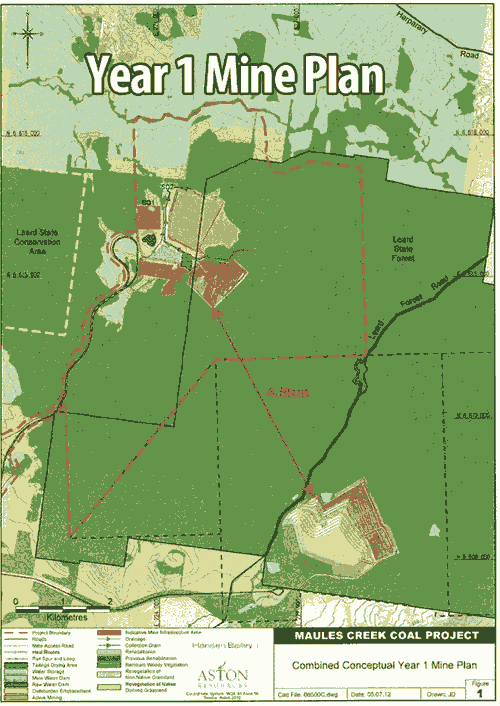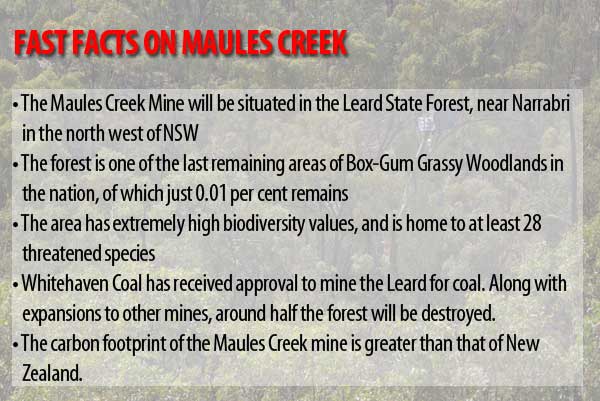Whitehaven Coal’s controversial Maules Creek Mine – one of the nation’s largest coal mines under construction and a project that will help destroy the critically endangered Leard State Forest – appears increasingly unlikely to ever return a profit.
New Matilda has obtained copies of closed-door submissions in which Whitehaven lobbies the federal government over an approval condition which requires the company to maintain a ‘biodiversity corridor’ through the centre of the Leard State Forest, between Whitehaven’s Maules Creek Mine and neighbouring Idemitsu Resource’s Boggabri Coal Mine.
It is designed to mitigate the mine’s impact on threatened wildlife in the Leard by linking patches of remnant vegetation, as well as managing groundwater impacts which will be caused by the two open-cut coal mines.
In the submissions Whitehaven said the corridor is “a material risk to the project’s success”, one which the company “cannot accept”. The biodiversity corridor will prevent Whitehaven from mining around 16 per cent of the coal reserves it had bargained on for the controversial mine in north west NSW.
But after a leak by the NSW Baird government forced a premature federal approval, Whitehaven signed off on conditions which clearly require the biodiversity corridor to be maintained.
Whitehaven, which already faced a tenuous economic outlook, remains locked in talks with the federal government over the biodiversity corridor almost two years after a detailed plan was supposed to be signed off by the federal department of environment.

In the documents, obtained by New Matilda under freedom of information laws, Whitehaven lays out “high level calculations, to quantify in dollar terms, the coal sterilisation that would occur” as a result of the biodiversity corridor.
Whitehaven argues the corridor will cost $9.96 billion in lost revenues between the two mining companies.
According to Whitehaven’s figures 38.6 million tonnes of a total 240 million tonnes – or around 16 per cent of the project’s total coal resources – would be “sterilised” by the requirement for a biodiversity corridor.
Financial analysts have already questioned the mine’s ability to turn a profit in the deteriorating coal market, and the loss of coal reserves due to the biodiversity corridor will further undermine the company’s bottom line.
Whitehaven successfully used its assertions that the corridor was “a material risk to the project’s success” to lobby the state government, managing to wrangle a concession allowing for the biodiversity corridor to be relocated in the latter part of the mine’s lifespan.
The coal company then attempted to have the federal conditions changed, too.
But before the federal approval went through, Chris Hartcher, the then NSW resources minister who resigned in disgrace after this year’s ICAC investigations, grew impatient with a series of delays to the federal approval.
In an attempt to speed the mine’s approval, Hartcher leaked “commercially sensitive” information about the project, forcing a premature federal approval, just days after the then federal environment minister extended his decision-making time.
Minister Tony Burke approved the project on the same day as news of the leak broke, but despite Hartcher’s “unprecedented” move, the biodiversity corridor condition survived.
“It has always been my preference to minimise the number of planning and modelling processes which have to continue after a decision has been made because I want companies to be able to determine whether or not a project will go ahead on the basis of the conditions they see in my decision,” Burke said.
Tellingly, “the capital investment for the project and the benefits of the project more broadly” did not account for the coal “sterilisation” which the biodiversity corridor will cause, the FOI documents reveal.
Hartcher claimed he leaked the information because Burke was putting politics above economic return. Ironically though, he appears to have backed Whitehaven into an economic corner by forcing the federal approval before Whitehaven could negotiate a deal on the biodiversity corridor.
“The remaining work”, Burke said, would “be resolved directly between the company and myself,” with the NSW government to be cut out of the negotiations.
But Burke cut himself out of negotiations, which had not been settled by the time Labor lost office in 2013.
The biodiversity corridor remains an ongoing issue for the company and the federal government, nearly two years after Whitehaven was supposed to develop an adequate plan detailing how it would protect threatened flora and fauna.
In May 2013, a month after the project’s approval, Whitehaven’s biodiversity corridor plan was rejected. Had it been approved, the plan would have bound Whitehaven to honour the agreement to maintain a 500-metre wide corridor.
As it stands the vital environmental protection is not assured.
“The department is working with the proponent and the NSW Department of Planning and Infrastructure (DoPI) in relation to this Plan,” a spokesperson for the Department of Environment told New Matilda.
However the department would not comment on what was stalling the plan’s approval.
After two weeks of deliberations involving “security clearance”, a spokesperson would say only that “Whitehaven has not made any formal request or representations to the Department to alter or remove” the condition relating to the biodiversity corridor.
The spokesperson was unable to comment on whether Whitehaven had made ‘informal’ requests to abrogate or alter the requirement for a biodiversity corridor.
Whitehaven Coal also declined to comment on a detailed list of questions posed by New Matilda.

New Matilda asked specifically whether the mining giant intended to honour the federal approval condition, but the company declined to affirm their commitment to the biodiversity corridor.
In the negotiations over approval conditions Whitehaven said it doubts the biodiversity corridor will serve its intended functions of protecting the critically endangered forest and improving groundwater outcomes.
This puts the miner at odds with a string of government agencies and departments which have argued the biodiversity corridor is “critical” to mitigating the damage done by Maules Creek Mine to the Leard State Forest.
The critically endangered forest sits between Narrabri and Boggabri and is home to 30 threatened species and three critically endangered species, according to Whitehaven’s Biodiversity Management Plan.
“The threatened species known to occur is a very high number, higher than that found in many of our National Parks,” local ecologist Phil Spark told New Matilda.
“The reason it is so high is because many of the species are dependent on the Box–Gum Woodland, of which so little remains,” Mr Spark said.
Just 0.1 per cent of Box-Gum Woodland survives national, and just 0.05 per cent in NSW.
The requirement for a 500-metre wide corridor is based on recommendations from the NSW Office of Environment and Heritage, which had argued this was the minimum width that would adequately mitigate the mine’s impact on the unique forest.
Many ecologists believe the corridor should be wider, but Whitehaven argued in its submissions that because many of the key threatened species of the Leard Forest are winged, the corridor isn’t needed to ensure their mobility between patches of remnant vegetation.
A suggestion which was subsequently dismissed as “bordering on biological nonsense” by a NSW Planning Assessment Commission (PAC) Review Report, which said most of the threatened species would not leave the under-canopy of the forest.
The PAC is of the view that a shared 500-metre wide corridor “is critical to the mitigation of biodiversity impacts from the two projects”.
The environmentalists who have been fighting Whitehaven Coal for years agree, and are sceptical of Whitehaven’s commitment to biodiversity outcomes.
“Whitehaven has been clutching at straws, trying to justify why it should be able to mine this important biodiversity corridor in this special forest, when really it’s about boosting their profits,” Nic Clyde, a Senior Climate Campaigner at Greenpeace Australia Pacific said.
“The NSW Department of Premier and Cabinet has recognised this forest as having “irreplaceable, ecologically unique values”.
“It took a Land and Environment Court case to stop their winter clearing plans,” – an issue New Matilda has previously reported on – “and now this,” Mr Clyde said.
“If they’re not prepared to follow the rules, then they should not be allowed to mine in Australia.”
Whitehaven Coal has faced other legal actions in the NSW Land and Environment Court, too, as well as opposition on the ground, with over 290 protestors being arrested to date.
In November 2014 David Pockock, the former captain of the Wallabies, and Professor Colin Butler, an author to the recent Intergovernmental Panel on Climate Change report, were arrested over protest actions at Maules Creek.
According to Butler’s police fact sheet, Whitehaven intends to sue him for $40,000 for his civil disobedience.
But the challenge of multiple court cases and continuous protests may be less worrying for Whitehaven Coal than the increasingly gloomy economic outlook for the project in a declining coal market.
Even without the economic wound opened up by the federal government’s requirement for a biodiversity corridor, Whitehaven’s business proposition for its Maules Creek Mine is looking increasingly shaky.
“At current coal prices it doesn’t look great,” Rod Campbell, an economist and Research Fellow at The Australia Institute, told New Matilda.
"Whitehaven shares were over $7 in 2011 and they’re now down at $1.23, so I don’t think markets see a particularly optimistic future for the profitability of Maules Creek Mine,” Mr Campbell said.
Based on figures from this week, industry experts told New Matilda it is likely coal out of Maules Creek would make a loss.
Mr Campbell said the economics of the Maules Creek project have been questionable from its inception.
During the approvals process Mr Campbell claimed to have discovered billions of dollars in economic miscalculations by a firm contracted by Whitehaven.
Mr Campbell’s misgivings were later confirmed by Jeff Bennett of the Australian National University who was contracted by Whitehaven to check the figures.
The proponent had overstated the value of the project to the public by around 40 per cent, Mr Campbell revealed in a blog post for Economist at Large.
The figures used to justify the Maules Creek Project in the mine’s Economic Impact Statement were grossly exaggerated too, Mr Campbell said.

Whitehaven had been expecting prices of “US$96/tonne for thermal coal, US$135/tonne for semi-soft coking coal” and an “average exchange rate of 0.76”, according to its Economic Impact Statement.
But since the mining boom, coal prices have virtually halved and the Australian dollar has dropped significantly.
However, it remains well above Whitehaven’s expected long-term average.
"My big beef is with a planning process that is prepared – and successive governments that are prepared – to accept an economic process that is almost certainly fiction,” Mr Campbell said.
“When people do point out that what’s being presented in terms of the economics of major projects, and major coal projects in particular, don’t stack up, this advice is ignored by the planning department and by the government.”
“This is the case broadly and it was certainly the case with Maules Creek.”
Mr Campbell said that governments had ignored warnings from economists.
“[Governments] don’t wan’t to hear it, because they’re used to just approving more coal mines – that has been their strategy about rural development,” Mr Campbell said.
“The idea they might actually have to start planning instead of approving would mean they would actually have to start doing some work.”
Despite the planning department’s widely acknowledged willingness to approve coal mines, Maules Creek Mine is the only major greenfield mine under construction in NSW, because brand new projects are much more expensive to develop.
“At current prices it’s certainly not going to make much and anyone who’s investing is clearly gambling on increases in coal prices,” Mr Campbell said.
Unfortunately for Whitehaven Coal, a growing cohort of industry analysts – including Tim Buckley, a former head of Equity Research at Citigroup – believe the decline is structural, and prices will continue to fall.
Buckley is the director of the Institute of Energy Economics and Financial Analysis (IEEFA), which “views the global seaborne thermal coal market as having entered structural decline.”
“The EU and US markets are mature, with limited electricity sector growth, increasing energy efficiency plus regulations and significant increases in renewable energy capacity still being added, plus gas in the US.”
“As such, thermal coal demand is forecast to continue to decline,” Mr Buckley said.
“The IEEFA expects China, the world's largest consumer of thermal coal, will see peak demand by 2016, and a gradual decline thereafter.”
Chinese economic growth has already slowed and thermal coal demand in the 2014 year-to-date is already down 1.5 per cent year-on-year.
China has also recently slapped new tariffs on imports of Australian coal and introduced measures to improve energy efficiency and combat pollution.
“China continues to rapidly diversify its electricity grid through a massive investment program across nuclear, gas, wind, solar and hydro-electricity – all of which diversifies China away from thermal coal,” Mr Buckley said.
The IEEFA also “views the recent energy policy initiatives as flagging a major structural shift in the Indian economy,” which had been a big hope for Australian exporters.
“With a plan to invest US$100 billion by 2019 in new wind and solar capacity, and US$50 billion in the expansion and improvement of the national grid, India looks set to rapidly diversify its electricity sector away from thermal coal,” Mr Buckley said.
Added to this is the fact that Indian Energy Minister Piyush Goyal stated a month ago that his plans may see India cease thermal coal imports within 2-3 years.
These portentous rumblings are exacerbated by what appears to be a major shift in the global political mood around the transition towards renewables, as momentum gathers for the Paris climate talks.
China and the US recently signed an historic deal to cut emissions, and both countries have pledged US$3 billion to the Green Climate Fund.
Whitehaven’s Maules Creek Mine is yet to extract any coal, and was blocked from clearing any more of the critically endangered Leard State Forest until mid-February by a recent NSW Land and Environment Court case.
The company’s setbacks at Maules Creek are all the more damaging because it views Maules Creek Mine as “a transformational asset”, according to its most recent annual report.
Once operational, the project would more than double the miner’s output – a gamble that has demanded significant resources.
However the potential loss of 16 per cent of total coal reserves due to the biodiversity corridor condition creates another quandary for Whitehaven, which has already endured some of the stiffest community opposition ever faced by a coal mine.
Whitehaven Coal aims to be a low-cost, high-volume coal producer, but the litany of hurdles the company has had to jump could very well leave it exhausted.
Phil Laird, a spokesperson for the Maules Creek Community Council, whose family is the namesake of the forest, surmises what appears to be an increasingly likely eventuality: “We’re very concerned the company will just construct the mine in time to go broke.
“Maules Creek Coal cannot support a specific project approval that sterilises over 16 per cent of the coal resource,” Whitehaven said in their submissions to the state government.
But it did.
Without ignoring consistent and repeated advice from the NSW Office of Environment and Heritage, the Planning Assessment Commission and its own bureaucrats, the federal government can’t roll over on the biodiversity corridor.
Whitehaven is set to resume clearing the Leard State Forest in February, but whether that will bring the embattled company any nearer to a healthy profit is increasingly unclear.
Donate To New Matilda
New Matilda is a small, independent media outlet. We survive through reader contributions, and never losing a lawsuit. If you got something from this article, giving something back helps us to continue speaking truth to power. Every little bit counts.



